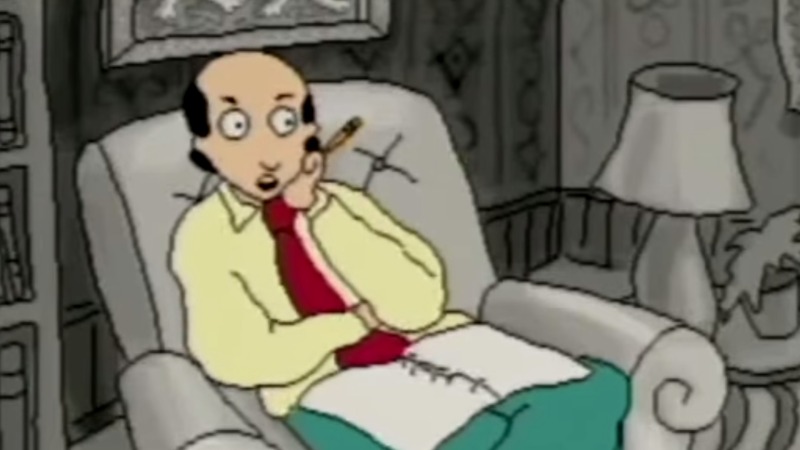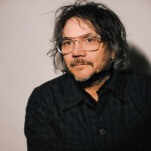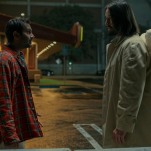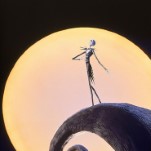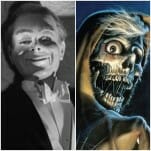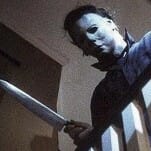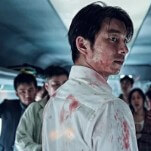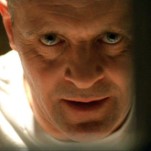No, he’s another Tom Snyder altogether. Still, while our Tom Snyder might not be the Tom Snyder from the pioneering Tomorrow Show and The Late Late Show, he nonetheless remains a Tom Snyder, and indeed the one who created the long-running, shamelessly DIY bellwether of adult modern-day animation Dr. Katz, Professional Therapist—a show which ran for 81 episodes from 1995-2002, spawned and was the inheritor of multiple spinoff iterations, and was feted with such accolades as the Emmy, Peabody and CableACE Awards.
Now, I know what you’re thinking. “Is he really going to be speaking to me in second person as the ‘correlative other’ throughout the whole article? What is this, the book-not-movie Bright Lights, Big City?” Well, you’ll just have to keep reading to find out. And kudos on your erudite use of the phrase “correlative other” and reference to Jay McInerney’s trenchant bildungsroman career launcher. No need to see the film adaptation, incidentally. Michael J Fox is great. That movie, however, is… not.
Sure, Katz is the face and literal voice of the series. He’s the living embodiment of the show’s principal wobbly avatar. He’s the mascot, the figurehead and the actual head on the opening title card. But, still, Katz is the co-creator, and Snyder is the progenitor: creator numero uno.
“When I first had this idea of doing a show about this therapist and his son,” Snyder recalls, “I was at this party and was talking to someone who asked what I was up to. I told him about the idea for the show and he asked if I was going to be making fun of therapy. ‘No,’ I laughed. ‘Actually, I’m in therapy myself. For quite a long time.’”
For Snyder, the difference between someone who might be doling out ostensible life advice versus a person’s who’s an outright professional therapist is the difference between a “very nice person” he saw once who was helping him work some issues out and a bona fide professional therapist at whose office he left a book after a session. The professional? She went to the trouble of, two hours later, tracking him down and getting him back the book. The very nice person who had been kindly offering counsel? No book recovery whatsoever. The contrast, in Snyder’s mind, is pretty darn clear.
Dr. Jonathan Katz is a divorced therapist at the center of an eponymous animated series that initially kicked off as seven one-minute short segments on Comedy Central’s Short Attention Span Theater (hosted by a young Marc Maron) before going to full series in 1995. It ran for 81 episodes until 2002 as Comedy Central’s first original cartoon show, produced/animated in part by first-timer Loren Bouchard, who would go on to co-create the similarly DIY-animated Home Movies as the first original series on Cartoon Network’s Adult Swim and eventually serve up the massive hit of a family-friendly feast Bob’s Burgers.
Dr. Katz must meanwhile put up with his cattily sardonic receptionist voiced by real-life Sarah Silverman’s real-life sister Laura. He additionally suffers through an amusingly stereotypical relationship with his live-in twenty-something son, Benjamin. Voiced by future cartoon voice actor all-star H. Jon Benjamin (at the time, the real-life Laura’s real-life boyfriend), Benny is clearly shrewd and quick-witted. But he’s also rather lost on his path toward adulthood, in ironic need of — well — a good therapist.
Over the years, the real-life Jonathan Katz (who was never a real-life therapist, but has been mistaken as one due to the longevity and legacy of his cartoon) has long traveled around the country speaking about and “doing” his show onstage. One such notable exhibition worth checking out, for instance, was captured for on tape with 2007’s An Evening with Dr. Katz: Live from the Comedy Central Stage. Audible then continued the series via audio-only segments in 2017.
And … you know what the music means …
For the aforementioned uninitiated, you probably won’t get that last line. For the fans, you do know what the music means: THE END.
Truth be told, the Dr. Katz character was not a “great” therapist, Snyder notes. He was never supposed to be. The show, lest we forget, was a Comedy Central production. This necessitated some humor in the DNA of the show’s storytelling and character development. What better way to manifest this humor than through a fairly imperfect central figure who, while making suggestions here or there to the endless parade of comedians slogging willy-nilly through his office, was kinda not so great at what he does?
What meanwhile brings his patients (and audiences) back time and time again (Ray Romano, for one, appeared in five different episodes; Dom Irrera was on so many times even ChatGPT evidently cannot muster up the computing power to help find the exact number) is the “humanity” with which Snyder, Katz and the various writers who came and went on the series imbued the good doctor. Dr. Katz may not always succeed, but his heart is in the right place.
If it weren’t, after all, he’d die, as would anyone else.
A typical episode of Dr. Katz, Professional Therapist opens with a characteristic New Yorkishly Seinfeld-ian jazzy riff. The music was made by Snyder, who wore many hats on the show, including developer and programmer of the trademarked software used to uniquely and cheaply animate the show in its signature frenetically palsied “Squigglevision” style.
We normally then see the kickoff of the episode’s plot, such that it is, amidst the already-activated quotidian goings on of Katz and overgrown 25-year-old Benny, whom voice actor Benjamin refers to in real life as a “failson” since the kid is, well, a failure. Katz may be asking his son why he eats so much sugary cereal. A simple enough premise that leads to Benny pledging in a following scene to never eat his precious Panda Puffs (think Teddy Grahams … as a cereal) again, with father vocally exuding pride over the phone … until he clearly hears Benny’s chomping on something rather crunchy. When questioned about the suspicious noise, Ben has to confess, “I’m eating cereal. Because, you know what? Screw pledges.”
And … scene.
Or, perhaps it’s a back and forth in the office between Katz in his therapy chambers, Laura his secretary on the phone in the front waiting room groaning (somewhat) subtly while they converse over the intercom about the fact that Laura can’t keep speaking with him when she’s so busy on the other line trying to rent out her apartment. Will he please stop interrupting her?!
There’s also Katz’s watering hole, Jackey’s 33, at which the harried head shrinker will, by day’s end, normally pop in for a beer or two (or more). He’s inevitably joined at the bar by his pal Stan and ubiquitous, exotic, and savvy bartender Julie. Katz will just as frequently drop a new (dad) joke on them — usually without warning Julie and Stan that the story is leading to a jokey punch line — and they usually in turn groaningly humor him at story’s end. Sometimes more patronizingly than others, but it’s clear that they find the man funny and enjoy his company as much as he enjoys theirs. It’s NYC, after all, and there are plenty of other places to go for a drink … or a bartender gig.
For the flesh-and-blood Jonathan Katz, those ongoing scenes — Dr. Katz and his son Ben, Katz and his secretary Laura, his secretary Laura and his son Ben who can’t stop bothering her with what may be an adorably unrequited crush but may just as easily be a circadian tick of his otherwise empty and busy day, and the trio of Stan and Julie and he kibitzing at the local bar — is what the show is really about.
Mention those fragments out of each episode in between the more “marketable,” shall we say, draw of the show — Katz’s character in his therapist’s chambers acting as straight man to whatever two or three comics he may have on the couch that week — as “interstitials,” and the man bristles.
But, such good fun it is to watch and listen to a slew of top comedy minds riff in a cartoon — even when it’s those who are only offering up their “B material” (Bill Maher infamously stepped into the recording booth appalled that they wanted him to deliver his jokes on their show, and immediately left once he better understood the premise; Rodney Dangerfield thought they were fucking with him and spent most of the recording for his segments in a state of actual exasperated discomfort and confusion at what they’re doing in the booth).
Inspired as a child by the earliest inklings of long-form comedic improvisation first developed by, for a bit of cosmic bashert here, therapist Viola Spolin and her son Paul Sills (who would go on to establish the mid-twentieth century Compass Players prior to Second City, which laid the seeds from which virtually all future improv comedy would blossom), Snyder was so astonished, especially by the works of early improv acolytes Mike Nichols and Elaine May, that it stuck with him decades later when it was time to create and produce his own humor-filled series.
Hence, as Snyder reveals, “There were scripts for Dr. Katz between the ‘patients’ on the couch and Katz. We just never stuck to them.”
Instead, either in-person or occasionally over the phone (well before such concepts as “virtual” meetings were ever considered a remote possibility), Bouchard and Snyder would record the comics doing their bits, and would record them gabbing back and forth with Katz (who, as straight man, might simply pepper in an occasional “Mmm hmm” or “Right” or “Yup” atop their freeform riffing) and would then edit together only the freshest, crispest parts.
The son of a music teacher and a musician himself, Bouchard had first met Snyder as his elementary school piano teacher, only to run into his former instructor years later in his early twenties while barely scraping by as a bartending high school dropout. Luckily for Bouchard, Snyder had been approached by a friend to offer up some ideas for cheap animated content that could fill some time on a new cable channel that was coming together that would ultimately be called Comedy Central. Snyder, who had left his teaching gig to work full-time expanding his successful educational software company that he’d started as a precocious child, obliged by drumming up his Squigglevision software. Soon thereafter, Snyder was bringing his erstwhile student Bouchard along for the ride.
As they were both musicians, it’s no wonder Snyder and Bouchard saw the recording and cutting of the audio clips for Dr. Katz as a kind of jam session that would then need to be mixed and edited together — not unlike what you hear when you’re listening to some of the great bebop, funk, and experimental rock records of the 1970s-1990s. If it could work for Charlie Parker, if it could work for German noise-rockers CAN and if it could (much later on, but still …) work for Radiohead front man Thom Yorke’s solo career … why couldn’t it work for human voices on a DIY animated series? Answer: It evidently did.
“We would come up with concepts and ideas for the segments of each episode, but I would say only about 10% of what we would try to script would make it onto the finished edit,” Snyder calculates. The rest was just the comic riffing on his bits. In the very beginning, as recorded in a booth built by Bouchard and Snyder out of the latter’s kitchen pantry, lined with shelves that never wanted for cans of soup. Egg cartons nailed to what bare walls did exist were used to their full capacity for no-budget soundproofing.
To ensure they would be able to edit the very best of the best, Snyder and Bouchard would need to do all they could to facilitate the recording of the very best of the best spouting out of the comics’ minds and mouths. To do this, Snyder went to great lengths of further technological and engineering concocting. Including eventually building — with protégé Bouchard at his heels, swingin’ hammer in hand — a kind of mini-set of an actual bar and stage area replete with standing microphone.
The location of this faux comedy club was fabricated in the building, which housed his lucrative software company. Though he had nearly 200 employees working on all manner of projects, one floor of the building was now indeed dedicated to the recording and production of Dr. Katz, Professional Therapist.
Of those 200 employees, there was a happy percentage of fairly pretty young secretaries and assistants, Snyder discloses. And as such, he would bring them in — along with other employees as needed — to act as not so much of a focus group as a live audience who could listen in to the comics being recorded.
Bouchard and Snyder double-downed to design and create a specialized wiring system in which those being mic’d could hear the audience laughing at their jokes in real time on the other side of their enclosed comedy club/recording booth, without the sound of that laughter showing up on the recording.
This allowed the comics to really deliver, Snyder says. And the fact that many of those in the faux comedy club audience were pretty, young things helped really drive the best material because, as Snyder put it, “Comedians are kind of trying to get laid when they’re in clubs. They really want to know that they’re doing well. It’s incredibly important to give them that sense. To just throw someone in the booth without anyone listening in except for the engineers and director and say, ‘Do some of your material’ won’t work very well.”
Bouchard and Snyder also soon realized that they in fact had to remove Katz from the recording booth altogether, too. His being there with the comics was slowing them down, breaking up their rhythm and flow. They’d be delivering the goods, and Katz would pop in to say something as a, you know, therapist. In those earliest days, Katz would actually try to be something slightly more than a straight man nodding his head, saying “Mm hmm,” and “Wow, huh.”
That initial, instinctual approach to the show screwed the comics up.
So, Katz was taken out of the booth, and, in the end, the best recordings from that point on were those in which the comics were permitted to just do their thing, untrammeled and unrestrained by any intrusions whatsoever.
Bouchard and Snyder would then take what could sometimes be hours of material, listen to it on cassette tapes in their cars, pass the tapes around to friends and family, and determine which fragments were rendered funny enough by consensus to pull out for use in the show and which to kick to the magnetic tape curb.
“That was another piece of Tom’s strong insight,” Bouchard suggests. “We were able to do it this way, because digital editing was just coming online and we were some of the first people to get on it like that. It was 1993, and most people were still cutting physical tape. Tom was the one who came in and said, ‘No. With this new technology, you can do infinite edits. You can do hundreds and hundreds of edits. No one can do that on a piece of finite tape.’”
“With digital editing,” Snyder would preach, “you can try things and experiment and fool around.” And as a result, Snyder and Bouchard could get really creative with what they used and didn’t use from the recordings they captured.
“Especially when I look back on it now,” Bouchard reflects, “after everything else I’ve done over the years, I see that as such brilliant, blinding insight on the part of Tom. It was a conceptualizing of stuff that didn’t really exist beforehand. To have the vision it could work as a half-hour show, that was stunning.”
It was as though they were genetically engineering this gigantic mutant of a still-delectably-tasty turkey and then carved it up as needed to extract the preferred drumsticks, breasts and dark and white meat as needed.
This was about “really crafting the audio,” Bouchard is sure to add. “It’s not just cutting it down to time or finding funny jokes. It’s about approaching the material like music, understanding the rhythm of the human voice. Standup comics in particular have to really figure out how to hone their craft with just their voice and a microphone. When Eugene Mirman, who voices Gene Belcher on Bob’s Burgers, is asked at conventions and things how people can get into voice acting too, he always tells them, ‘Do standup comedy for 15 years.’ And he’s right. That’s not a joke answer. It’s a real answer.”
“And that’s what Tom and I were looking for then,” Bouchard continues. “People like Jon Benjamin who were gifted in their voices and in their minds to what they could bring us. We were mining the talent pool for what really was like these jazz soloists. Then our job was to create these little quartets and quintets and triplets, and have them come together and riff off of each other. Then make it sound musical as a finished piece of editing audio. It could take weeks. That really was the secret sauce of what helped us make Dr. Katz work so well. It was musical. It was like what Robert Altman was doing in his films like Nashville before us. You’re watching them going, ‘Good god, everyone is talking over each other, and yet you can hear everything perfectly!’ It’s a high-wire act that shouldn’t work, but it does.”
Snyder and Bouchard would then hand over the final audio of each 22-minute episode, which by then was really more like a 22-minute radio show, to their small but plucky animation team. This, in and of itself, is spectacularly singular in the realm of animation, whose hidebound process has always been that of: writing the script, animating what’s been written and then bringing in the vocal performers to read their lines while screening what’s been animated in order to match their voices to the characters onscreen.
Costs of animation at the time were still so astronomical, even in the recording stage, that there was hardly any room for improvisation, for riffing, for elaborating upon and expanding on a bit if the voice actor had the notion to do so. There wasn’t the money for it, there wasn’t the tape for it, there wasn’t the time for it (another version of money, really, for all of the engineers and staff and talent itself in the room).
So rare was it that a vocal performer would even be given the chance to go off on a tangent if the mood struck him, that it enticed the entire Hollywood comedy community for months when copies of a bootleg tape floated around of filmmaker, actor and comedian Albert Brooks doing just that during one of the many times he was featured on The Simpsons.
Show runner Al Jean remembers this stentorian exception to their otherwise needfully rigid schedule and command that talent stay exactly on-script. Due solely to the fact that the staff at The Simpsons loved Brooks so much, they decided to give him the time and tape to riff as long as he wanted during one of his recording sessions.
He did, and, shortly thereafter, some of the biggest names in the game — or those who were just making their way up the ladder such as contemporary comedy film maven Judd Apatow — got their hands on the tape and listened to it over and over again, both for the unbridled comic virtuosity of Brooks but also because it was so incredibly rare to hear someone on a show like The Simpsons be given the liberty to do what he did.
On Dr. Katz, Professional Therapist, the standard process that had been a staple of a century’s worth of animation history, was completely turned on its head. The vocal performances came first. The animation last. And screw the scripts altogether.
“We were doing a lot of very intentional shit to try to create the feeling we wanted to get across,” Snyder emphasizes. “When I hired Loren as a young kid, that’s what I wanted. And I had so much fun talking with him about that stuff, because he really rocked it and really got behind it. We were trying to figure out how it was like real conversation, how it was like music. Some of it was just tricks we’d have to use.”
What you’re therefore hearing on the show, particularly during the bits involving the standup comics on the couch, is essentially the selfsame brand of field recordings Alan Lomax, Studs Terkel and Harry Smith created in the earliest days of oral history as a potent new archival form. The difference being, of course, Lomax, Terkel and Smith never cut their finest few seconds and minutes together to tell a palatably-sized story. For them, it was all turgid books of transcripts running 600 pages or vinyls and tapes of ten hours each. For Katz: sorry, each episode is only 22 minutes plus commercials — where only the “good stuff” makes it in.
“That feeling of a live performance was part of the drama of the show,” Snyder says. “The other parts of the show — Dr. Katz with his son or with Laura — would also just be them alone in the booth with us on the other side. And they would be basically improvising in the same way too. They would have something of a script that Loren and Jonathan and the other writers would come up with in the back of their minds, but they wouldn’t carry the scripts in with them. That was really just them riffing off of each other.”
In this way, then, we have a further clue as to the specialness of Dr. Katz, being that it’s so very animated and cartoony, sketchily drawn and DIY, colorful and absurdist in format … and yet as truthful and authentic in what they’re “saying,” that it also relates heavily to the rather improvisational artistry of cinema verité renegades such as DA Pennebaker and the Maysles Brothers who would shoot and shoot and shoot real life (Bob Dylan, the Rolling Stones, traveling bible salesmen, John F. Kennedy, Kennedy’s strangely hermetic relatives Edith and Edie Beale, et al) and cut together, in something of a “story,” 90 minutes of the best of what they gathered.
“I do sometimes bridle at the idea that one of the things I’ll always be known for is the development of that wonky Squigglevision style on Dr. Katz,” Snyder carps. “But it’s also nice that we’re also known for its extremely innovative audio editing style, too. I probably worked for a year on my own on how to get the improv on the show right.”
“I love naturalism,” Bouchard proclaims. “But, the audio is also edited. It’s not just like going to an improv show and enjoying every single thing that’s coming out of a performer’s mouth. That’s great, too. But what I love more than that — because I’m a control freak and an editor by nature— is taking all of that in and then being able to refine it even more.”
Recording and editing the way they could and did was an innovation of technology, design, engineering and conceptual format that was bolstered by two other profoundly significant factors.
Firstly, the reason comics were essentially brought in to “play themselves” and why even the recurring regulars on the show were similarly basically just versions of themselves (including being so named) was that Snyder wanted to produce a cartoon show that, at long last, did not include any cartoon characters.
NO “VOICES” ALLOWED! That was the firm edict throughout the series. If anyone came in, particularly in the early days when folks were still figuring out and understanding exactly what the premise of Dr. Katz was all about, and they tried to ridiculously modulate their voice in any major way to establish some kind of conventional cartoony style, they were immediately told to cut that shit out. Snyder wanted realism. He wanted people on the show to sound like what they sound like in real life. Period.
This, too, was something very unique and perhaps groundbreaking in an animated series. You were not only hearing just people talking to each other or just delivering their standup comedy acts, but you were hearing them doing it and not some ersatz characterization of them doing it.
Vying for such dépouillé authenticity worked well too with the ebullient new brand of comedy that was coming up at the time from the late 1980s to the birth of Katz. A style some would call then and virtually all agree on calling now “alternative comedy.” It was more real, more raw, more autobiographical and far less “take my wife, please” joke-telling of the heyday of a more primordial standup era.
These were just funny anecdotes, often pulled from the chaos and calamity of the teller’s actual life.
“Alternative comedy was about being able to do something a little different than just the traditional, you know, jokes,” as Bouchard defines it. “Whatever was happening at that time with alternative comedy, it was being defined by a lot of the folks on our show. Benjamin was a great example of that, actually. Here he was on stage at the Boston bars, and he was basically a comedian without an ‘act’ at all. Jon Benjamin was there on stage doing ‘sort of improv’ but also just these weird ‘bits’ that Jonathan saw and then brought him onto the show. Jonathan had a lot of appreciation for the new, younger comics coming up at the time like that, and they really had a lot of appreciation for him, too.”
Presenting the series concept as a (rather static) vehicle for delivering standup comedy through the mode of therapy sessions, of all things, was a genius move on Snyder’s part, Bouchard declares, because even beyond the newfangled alternative comedy style, there was room on the show for that older, traditional “joke, punch line, joke, punch line” methodology that could still fit so well with the premise of comedy-as-therapy.
Particularly as, being that the show was animated and was a cartoon, they could still drop into the mix these absurdist visual representations of what the comics were talking about in their loony machinations and it would still somehow fit in with everything else smoothly in order to add some laughs, and sense of movement or variety to the show.
Dom Irrera’s animated avatar could be on the couch talking about a guy he saw whose toupee was so bad, it might as well have rocked a chinstrap … and through the magic of animation, the artists on the production could actually represent the illogical idea onscreen as a dream bubble of sorts seamlessly integrated into the continuation of Irrera sitting on the couch thoughtfully recounting his story.
“This was one of those once-in-a-lifetime ideas,” Bouchard breathlessly intones. “Perhaps it took Jonathan being a comic and having been in therapy a little bit to understand it and perform so well the way he did on the show. The fact that you could have these standup comics — even the ones who were more traditional like Larry Miller, and Dom Irrera and Wendy Liebman or even Ray Romano who would become big on the show — and it would still work in the context of a therapy session, was just a great, great insight on the part of Tom and Jonathan.”
Secondly, the other way Dr. Katz was able to so well nail such authenticity despite being a cartoon was the fact that, as rare as it was then and now, there was no interference from the network. Snyder, Bouchard and Katz were more or less left alone by the suits at Comedy Central to do their thing and make what they wanted to make. For seven years and 81 episodes.
Once in a while, the channel’s execs would bust in with a few suggestions here or there, but they could be ignored easily. (Even when they asked for, say, “more tits and ass,” as Snyder elaborates.)
“That was really the only thing they would sometimes bring up to us. They wanted us to try to bring up more sex on the show, but that wasn’t what we were about. Everything on the show was much more hinted at when it came to that kind of stuff. It was more about innuendo. Someone like Bill Braudis, who also wrote for the show, might come in and say something like, ‘My dad’s trying to get off of smoking, and he’s done everything including hypnosis and the gum and that thing with the needles? What is it? Heroin?’ That’s about as far as we’d go for that kind of thing.”
For Snyder, then, Dr. Katz worked best when it was less “startling” and more “warm and easy-going.” It hummed along most nicely when there weren’t any loud and crazy voices, when there wasn’t any artifice in the booth and character creation.
They had their own momentum, after all, and they didn’t need any of the usual flummery, just as they didn’t need to tiredly reference timely current events and sociopolitical issues coming up, didn’t need to go blue or delve down into the dregs of the scatological, sex and drugs craziness of some of the other adult animation series coming along at the time.
And, again, it was such a blessing that Comedy Central let them be what they were and seemed to dig on what was coming out of the system so meticulously developed and constructed by Snyder, Bouchard and Katz.
“It was one of the great labors of love of my life,” Snyder says. “I dedicated all creative energy and power I could muster to developing that show. And I’m also very proud that when I got the gig with Comedy Central, I chose Jonathan to play the doctor, because he was my favorite comedian. I think that was a spectacular piece of casting. And it launched a lot of careers, too. Including Loren’s.”
Casting and the talent brought onto the show was a prime element of what led to the success and continuous longevity of the show for Bouchard, as well.
“So much of what happened worked out because of the timing of it all,” Bouchard recalls. “There definitely was something happening in comedy at the time that was perfectly concurrent with the creation of Dr. Katz. It really set us up for success in a way that I didn’t even really appreciate back then when we were first making the show but see it as such now.”
Mathew Klickstein is a longtime pop culture historian whose previous books include those on such topics as Nickelodeon, The Simpsons, Comic-Con and Troma’s Lloyd Kaufman. He is currently working on a new book about—you guessed it—Dr. Katz, Professional Therapist.
